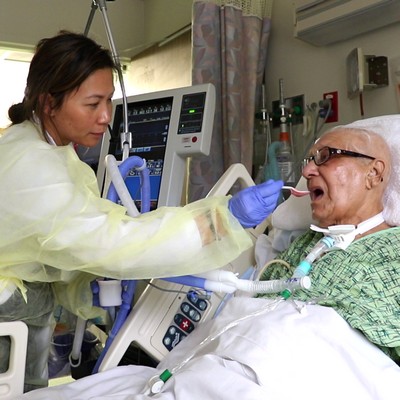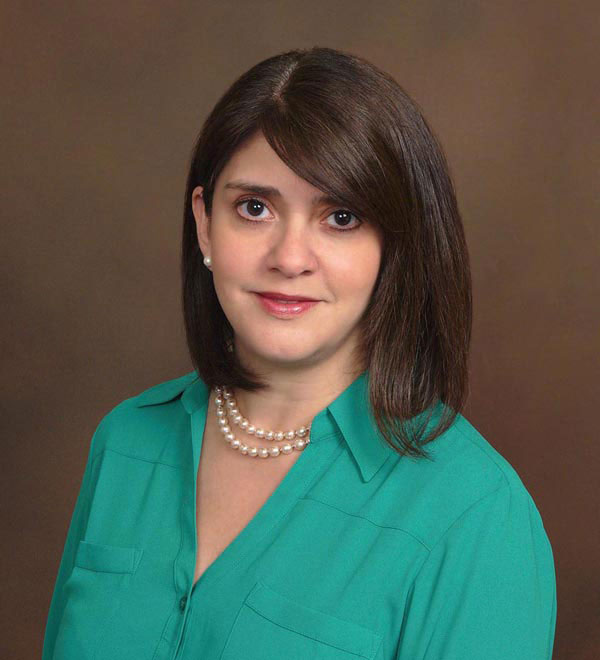Effects of PMV® In-line with Mechanical Ventilation on Communication and Swallowing
Maribel Ciampitti, MS, CCC-SLP

Annually, more than 100,000 patients in the United States experience medical events that require a tracheostomy, with 24 percent of those necessitating mechanical ventilation (Yu, 2010). It is estimated that by the year 2020, there will be over 600,000 patients requiring prolonged mechanical ventilation (Zilberberg, 2008). Most vented patients are on prolonged bedrest during hospitalization. In intensive care units across the country, efforts are being made to implement early mobility programs as there is significant evidence indicating that many patients in intensive care units on prolonged mechanical ventilation experience a marked decline in functional status (Spicher, 1987). After one week of bedrest, muscle strength may decrease by as much as 20 percent with an additional loss of 20 percent each subsequent week of bedrest (Perme, 2009; Sciaky, 1994). Why is this significant to speech-language pathology?
The loss of strength extends to the muscles of respiration and the oropharyngeal musculature, which affects communication and swallowing (Griffiths & Jones, 1999). Muscle weakness is an independent predictor of pharyngeal dysfunction and symptomatic aspiration. Patients with muscle weakness often have greatly reduced cough strength and poor control over their swallowing and upper airways (Griffiths & Jones, 1999). The implementation of early mobility and rehabilitation in the fields of physical and occupational therapy has shown positive outcomes in ICU patients (Adler, 2012). The same principles used to promote strength for mobility can be applied to strengthening the oropharyngeal and respiratory musculature to improve swallowing and communication (Burkhead et al., 2007). Two examples of these principles would be the overload principle, where physical capacity is challenged, and the principle of “specific adaptation to imposed demands” when the exercise is linked to the demand and function of the muscle (Trees, Smith, Hockert, 2013). The therapeutic intervention plans developed for voicing, communication, or swallowing often reflect these principles, addressing the muscles involved by using functional tasks which also directly address the demand and function of the muscles.
However, many times the medical team prefers to wait until the patient is weaned from the ventilator before consulting the speech-language pathologist on the basis that the patient is “too sick” to begin intervention for communication and swallowing. Considering that research has shown how disuse leads to muscular atrophy and weakness in relatively short periods of time, waiting to intervene may contribute to significant dysfunction of the speech and swallow mechanisms. Additional contributing factors in this patient population are that the anatomy and physiology of the swallowing and voicing mechanisms are significantly altered when a patient is tracheostomized and ventilated. The placement of a tracheostomy and prolonged mechanical ventilation with an inflated cuff causes a disconnect between the upper and lower airway. The lack of airflow through the upper airway can often lead to multiple negative changes affecting speech and swallowing: reduced subglottic pressure (Eibling & Gross, 1996), decreased sensation to the pharynx and glottis (Eibling & Gross, 1996), reduced laryngopharyngeal reflex (Sasakai, Suzuki, Horiuchi, Masatoshi & Kirchner, 1997), decreased ability to manage secretions requiring more frequent suctioning (Siebens et al., 1993), decreased sense of taste and smell (Lichtman et al., 1995), inability to vocalize, increased aspiration risk, and muscle disuse and atrophy (Griffiths & Jones, 1999). The weight of the tracheostomy tubing and an inflated cuff can decrease the range of motion of the hyolaryngeal mechanism by causing a tethering effect (Ding & Logemann, 2005; Bonanno, 1971).
Furthermore, patients on mechanical ventilation can experience discoordination of breathing, which can negatively impact speech and swallowing (Pringent et al., 2011).
The effects of tracheostomy and vent dependence are not just physical. For patients, the loss of the ability to communicate their everyday needs can lead to increased psycho-emotional distress, (Khalaila et al., 2011), including anxiety and depression (Chen et al., 2011). It robs patients of the ability to participate in their own care and decision making process. Studies have shown that the Passy Muir® Valve used in-line can, in many cases, restore early verbal communication to vent-dependent patients, facilitate the care given by healthcare personnel, enhance their mental outlook, and allow participation in their own care without observed complications (Sutt et al., 2015; Manzano et al., 1993; Passy et al., 1993). Communication is not just a patient right but a basic and important human right. Efforts should be made to facilitate the communication needs of ventilator dependent patients who are in both a vulnerable and difficult position.
The speech-language pathologist (SLP) is in a unique position to provide early intervention and rehabilitation to patients who are tracheostomized and on mechanical ventilation via early assessment for the use of a bias closed, no leak speaking valve (Passy Muir Valve) for in-line use with the ventilator. Early intervention by the SLP should begin by identifying patients on mechanical ventilation who are candidates for trials using the Passy Muir Valve (PMV®). The benefits of early assessment and implementation with the PMV are many. First and foremost, use of the PMV helps to restore the physiology of the upper airway to its more “normal” state by returning airflow through the upper airway during exhalation. This restoration of airflow to the upper airway allows evaluation of airway patency, vocal cord function, secretion management, and communication skills. In many cases, voicing is restored, allowing the patient to communicate basic needs and participate in their daily care. The restoration of communication also allows the SLP to conduct more thorough speech/language and cognitive assessments, which lead to earlier therapeutic intervention for patients who may have experienced other co-morbidities, such as stroke or traumatic brain injury. Without verbal communication or vocalizations, assessment of speech and language deficits would otherwise be very limited for patients on mechanical ventilation. With early assessment comes early therapeutic intervention and planning for care.
Swallow function is often negatively affected in patients who are tracheostomized and on mechanical ventilation. It is estimated that 50-87% of patients with tracheostomy aspirate, including silent aspiration (Elpern et al., 1987, 1994, 2000). Research suggests that tracheostomy speaking valves may positively impact swallowing function and rehabilitation (Blumenfield, 2011). Research also has demonstrated that early implementation of a swallowing rehabilitation program is feasible for patients on mechanical ventilation (Rodrigues et al., 2015). Physiologically, the bias closed, no-leak valve design of the PMV allows for restoration of subglottic air pressure which has been shown to decrease or prevent aspiration in some patients (Dettelbach et al., 1995). Implementation of the PMV in-line allows for more reliable swallow assessment both at the bedside and with instrumentation. Reliability increases with the return of functions such as cough, throat clear, and voicing. With the PMV in-line on mechanical ventilation, the SLP is able to evaluate the integrity of the aerodigestive tract and more thoroughly assess potential risk factors related to the function of the vocal cords, cough strength, and secretion management abilities. Furthermore, the redirection of airflow provides sensory stimulation to the oropharynx and can improve management of secretions, as well as improve taste and smell (Lichtman et al., 1995).
By providing earlier intervention and evaluation, many patients are able to progress safely to an oral diet, even while on mechanical ventilation. For those patients with dysphagia that are not candidates to begin an oral diet, PMV use can be instrumental in the swallow rehabilitation process. Almost all swallowing rehabilitation techniques require the restoration of subglottic pressure to achieve effective results. Almost all oral motor exercises, pharyngeal exercises, swallow maneuvers (such as the Mendelsohn and Supraglottic Swallow), and respiratory muscle strength training require a closed system and subglottic airway pressure. The rehabilitation process may begin with tasks as simple as getting the patient to relearn breathing through the upper airway again and working on managing secretions during PMV trials.
Many patients on prolonged mechanical ventilation also have decreased volumes and poor expiratory strength, which affect swallowing and may place a patient at higher aspiration risk (Gross et al., 2003). PMV® use allows patients to participate in respiratory muscle strength training, which has been shown to improve voicing and swallow function (Sapienza & Trocher, 2012). Although many patients successfully tolerate PMV trials on initial attempts, not all tracheostomized patients will be immediately successful. Furthermore, not all swallowing function is improved by tracheostomy tube occlusion; therefore, other variables will need to be considered and evaluated (Donzelli et al., 2006). It is important to work with a multidisciplinary team to troubleshoot potential issues that may affect PMV tolerance, such as trach tube size, upper airway pathology, and underlying medical issues or co-morbidities, so that patients receive the best standard of care and are set up for success with the PMV.
Healthcare professionals who work with medically complex patients on mechanical ventilation face many challenges. Tracheostomized and vented patients are best served by multidisciplinary teams including physicians, respiratory care practitioners, nurses and speech-language pathologists. Other important team members include dieticians, physical and occupational therapists, psychologists, and social workers. The research evidence suggests that early intervention with the Passy Muir® one-way valve on mechanical ventilation may lead to improved outcomes. Research has suggested reduced weaning times, improved communication and swallow function, reduced hospital length of stays, reduced cost of care, and overall improvement in the quality of life (Speed & Harding, 2013; Cameron et al., 2009). Studies have shown that waiting until the patient is weaned to intervene can contribute to disuse and atrophy of the speech and swallowing mechanisms leading to significant communication and swallowing deficits. Furthermore, patients on mechanical ventilation often experience psychosocial distress related to their inability to communicate with family and caregivers and to participate in their own care. Early implementation of the Passy Muir® Valve, in-line during mechanical ventilation, increases the opportunity for patients to speak, swallow, and participate in direct therapy sooner and has the potential to reduce anxiety, wean times, and lengths of stay. Delayed intervention could potentially complicate efforts to liberate patients from the ventilator, as prolonged ventilation carries risks.
Practices in the timing of speech-language pathology intervention for patients on mechanical ventilation vary across medical settings. Because early intervention addressing communication and swallow function has been shown to have a significant impact on patient outcomes, efforts should be made by speech-language pathologists to evaluate current protocols in ICUs and other medical settings to promote early intervention for patients with transient or chronic vent dependency.
This article is from Volume 6 Issue 1 of Talk Muir Fall 2016. Click here to view Effects of PMV® In-line with Mechanical Ventilation on Communication and Swallowing.
References
Adler, J. and Malone, D. (2012). Early Mobilization in the Intensive Care Unit: A Systematic Review. Cardiopulmonary Physical Therapy Journal, 23(1).
Blumenfield, L., Salgado M., Wade K., Dhupa A., Ling E., and Belafsky P. (2011). The effects of Tracheostomy Speaking Valve use on Disordered Swallowing. DRS Poster presentation.
Bonanno P.C. (1971). Swallow dysfunction after tracheostomy. Annals of Surgery, 174(1): 29-33.
Burkhead, L., Sapienza, C., and Rosenbek, J. (2007) Strength-training exercise in dysphagia rehabilitation; principles, procedures and directions for future research. Dysphagia, 22(3): 251-65.
Cameron, T., McKinstry, A., Burt, S., Howard, E., Bellomo, R., Brown, D., Ross, J., Sweeney, J., and O’Donoghue, F. (2009). Outcomes of patients with spinal cord injury before and after the introduction of an interdisciplinary tracheostomy team. Critical Care and Resuscitation, 11(1), 14-19.
Chen, Y., Jacobs, W.J., Quan, S.F., Figueredo, A.J., and Davis, A.H. (2011). Psychophysiological Determinants of Repeated Ventilator Weaning Failure: An Explanatory Model. American Journal of Critical Care, 20(4), 292-302. doi:10.4037/ajcc2011886
Dettelbach M.A., Gross R.D., Mahlmann J., and Eibling D.E. (1995). Effect of the Passy-Muir Valve on aspiration in patients with tracheostomy. Head Neck, 17(4): 297-302.
Ding R. and Logemann J.A. (2005). Swallow physiology in patients with trach cuff inflated or deflated: a retrospective study. Head & Neck, 27: 809-813.
Donzelli J.L. Brady S., Wesling M., and Theisen M. (2006). Secretions, occlusion status, and swallowing in patients with a tracheotomy tube; a descriptive study. Ear Nose Throat Journal, 85(12): 831-4.
Eibling D.E. and Gross R.D. (1996). Subglottic air pressure: A key component of swallowing efficiency. Annals of Otology, Rhinology & Laryngology, 105(4):253.
Elpern, E.H., Borkgren, M., Bacon, M., Gerstung, C. and Skrzynski, M. (2000). Effect of the Passy-Muir Valve on pulmonary aspiration in adults with tracheostomies. Chest, 116(4-S2):365S.
Elpern, E., Jacobs, E.R. and Bone, R.C. (1987). Incidence of aspiration in tracheally intubated adults. Heart & Lung, 105(2):527.
Elpern, E.H., Scott, M.G., Petro, L., and Ries, M.H. (1994). Pulmonary Aspiration in Mechanically Ventilated Patients With Tracheostomies. Chest, 105.2 (1994): 563-66.
Griffiths, R.D. and Jones, C. (1999). Recovery from intensive care. British Medical Journal, 319-427.
Gross, R.D., Atwood, C.W., Jr., Grayhack, J.P., and Shaiman, S. (2003). Lung volume effects on pharyngeal swallowing physiology. Journal of Applied Physiology, 95(6), 2211-2217.
Khalalia R., Zbidat W., Anwar K., Bayya A., Linton D.M., and Sviri S. (2011). Communication difficulties and psychoemotional distress in patients receiving mechanical ventilation. American Journal of Critical Care, 20(6): 470-9. doi:10.4037/ajcc2011989
Lichtman, S.W., Birnbaum I.L., Sanfilippo, M.R., Pellicone J.T., Damon, W.J., and King M.L. (1995). Effect of tracheostomy speaking valve on secretions, arterial oxygenation, and olfaction: A qualitative evaluation. Journal of Speech and Hearing Research, 38: 549-555.
Manzano, J.L., Lubillo, S., Henríquez, D., Martín, J.C., Pérez, M.C., and Wilson, D.J. (1993). Verbal communication of ventilator-dependent patients. Critical Care Medicine, 21(4), 512-517. doi:10.1097/00003246-199304000-00009
Mirzakhani, H., Williams, J.N., Mello, J., Joseph, S., Meyer, M., Waak, K., Schmidt, U., Kelly, E., and Eikermann, M. (2012). Muscle Weakness Predicts Pharyngeal Dysfunction in Symptomatic Aspiration in Long-term Ventilated Patients. Anesthesiology, 119(2): 389-397.
Passy V., Baydur A., Prentice, W., and Darnell-Neal, R. (1993). Passy-Muir tracheostomy speaking valve on ventilator-dependent patients. Laryngoscope, June; 103(6): 653-8.
Perme C., and Chandrashekar R.K. (2008). Managing the patient on mechanical ventilation in ICU: early mobility and walking program. Acute Care Perspectives, 17(1): 10-15.
Prigent, H., Lejaille, M., Terzi, N., Annane, D., Figere, M., Orlikowski, D., and Lofaso, F. (2011). Effect of a tracheostomy speaking valve on breathing–swallowing interaction. Intensive Care Medicine, 38(1), 85-90. doi:10.1007/s00134-011-2417-8
Rodrigues K.A., Machado, F.R., Chiari B.M., Rosseti H.B., Lorenzon P., and Goncalves MIR (2015). Swallowing rehabilitation of dysphagia tracheostomized patients under mechanical ventilation in intensive care units: a feasibility study. Revista Brasileira de Terapia Intensiva, 27(1): 64-71.
Sapienza, C.M., and Troche, M.S. (2012). Respiratory muscle strength training: Theory and practice. San Diego: Plural Pub.
Sasaki, C., Suzuki, M., Horiuchi, Masatoshi, H., and Kirchner, J.A. (1997). The effect of tracheostomy on the laryngeal closure reflex. The Laryngoscope, 87: 1428-1433.
Sciaky A.J. (1994). Mobilizing the intensive care unit patient: pathophysiology and treatment. Phys Ther Pract, 3(2): 69-80.
Siebens, A.A., Tippett, D.C., Kirby, N., and French, J. (1993). Dysphagia and expiratory air flow. Dysphagia, 8(3), 266-269. doi:10.1007/bf01354549
Speed, L. and Harding, K.E. (2013). Tracheostomy teams reduce total tracheostomy time and increase speaking valve use: a systemtic review and meta-analysis. Journal of Critical Care, 28(2):216.
Spicher, J.E. and White D.P. (1987). Outcome and function following prolonged mechanical ventilation. Arch Intern Med, 147(3): 421-425.
Sutt, A.L., Cornwel, P., Mullany, D., Kinneally, T., and Fraser, J. (2015). The use of tracheostomy speaking valves in mechanically ventilated patients in improved communication and does not prolong ventilation time in cardiothoracic intensive care unit patients. Journal of Critical Care, 30:491-494.
Trees D.W., Smith J.W., and Hockert S. (2013). Innovative Mobility Strategies for the Patient With Intensive Care Unit–Acquired Weakness: A Case Report. Physical Therapy, 93:2, 237 – 247. doi:10.2522/ptj.20110401.
Yu, M. (2010). Tracheostomy patients on the ward: multiple benefits from a multidisciplinary team? Critical Care, 14:109T.
Zilberberg, M. and Shorr, A. (2008). Prolonged acute mechanical ventilation and hospital bed utilization in 2020 in the United States: implications for budgets, plant and personnel planning. BMC Health Services Research, 8:242.











